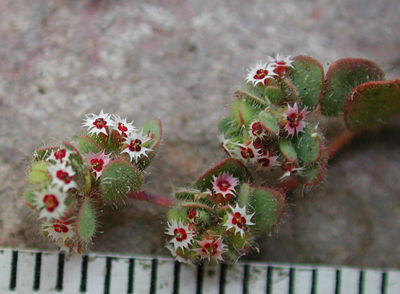Yuma Sandmat
Yuma Spurge
Euphorbia (Chamaesyce) setiloba

This photo was taken in Maricopa Co., Arizona, Oct. 2007. A full resolution image is hosted at Wikimedia. The ruler is scaled in millimeters.
Sponsored Links:
RANGE: Locally common in deep sandy soil as in dune areas, wide sandy washes
and flood plains of rivers mostly at lower elevations in the Sonoran Desert. Intense direct and indirect sunlight.
Over 40 kinds of Euphorbia can be seen in Arizona - this is among the more distinctive.
ANNUAL/PERENNIAL: Generally grows as an annual, prostrate on the soil
with a few stems rising up to 7 cm..
This herbaceous plant blooms the first year and may survive beyond a
single year if conditions remain favorable.
LEAVES: The nearly ovate leaves are decked with glistening white hairs
that help deflect some of the intense insolation. The leaves are strictly
opposite on the stems and are unequal and the margins are entire.
FLOWERS: What at first appears to be a lovely little flower barely a millimeter
in diameter is actually an involucre (cup-like structure) enclosing several male
staminate flowers and one pistillate female flower. The surrounding glands and the lobed appendages form the rim of the vase-shaped involucre. Flowers can appear almost any time of year if moisture is favorable.
UNARMED: No thorns, but the milky sap can be a skin/eye irritant.
FRUIT: Very small, setose capsules, about 1 mm, are three-parted and each
contains usually three seeds. These seeds inside require high magnification to see
their wrinkled surface.